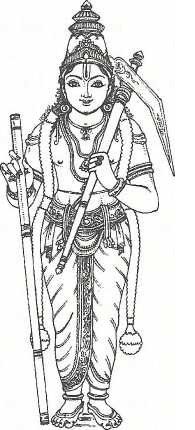Talk:Balarāma
By Swami Harshananda
Balarāma literally means ‘Rāma of strength’.
Balarāma was the elder brother of Kṛṣṇa. He was conceived as the seventh son of Devakī by Vasudeva. But the foetus was drawn out of her by Yogamāyā (divine power) and placed in the womb of Rohiṇī, the elder wife of Vasudeva, living at Nandagokula. So he was born as the son of Rohiṇī. Since he was extraordinarily strong, he was called ‘Balarāma’ (bala = strength). He had several other names like Saṅkarṣaṇa, Rauhiṇeya, Musalī, Hali, Nīlāmbara and so on.
As per the paurāṇic lore, he was the incarnation of Ādiśeṣa (the serpent on which Viṣṇu is resting in the Kṣīrasāgara or ocean of milk) came down to help Kṛṣṇa who was Viṣṇu himself. He was an expert in fighting with gadā or mace. The plough (halā) was his favorite weapon. The Bhāgavata describes several tales of his exploits. Along with Kṛṣṇa, he killed many demons like Pralamba, Dhenuka, Dvivida and Balvala.
After the killing of Kamsa by Kṛṣṇa, Balarāma got his formal education under the sage Sāndīpani. He married Revatī, the daughter of the king Revata. When the Kauravas of Hastināpura abducted Sāmba, a son of Kṛṣṇa, he personally rescued him. He taught gadā-vidyā (the science of fighting with the mace) to Bhīma (the second of the five Pāṇḍavas) and Duryodhana (the eldest of the Kauravas). He had a soft corner for his favorite student, Duryodhana.
During the Kurukṣetra (or Mahābhārata) war, he refused to participate and went away on a pilgrimage. He reappeared at the time of the duel between Bhīma and Duryodhana. He tried to prevent it but did not succeed. He got cross with Bhīma for having flouted the rules of mace-fighting but was pacified by Kṛṣṇa. When the Yādavas exterminated one another in mutual fighting, Balarāma sat in yogic stance and left the body in the form of a serpent, thus confirming that he was Ādiśeṣa.
References[edit]
- The Concise Encyclopedia of Hinduism, Swami Harshananda, Ram Krishna Math, Bangalore


